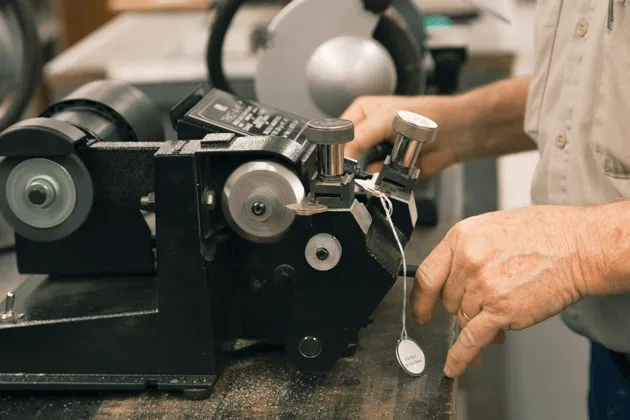Inside UT's Old-School Lock and Key Shop

When they’re in a hurry—and they often are—members of UT’s Lock and Key Services staff tap three times on the button for the pneumatic tube they use to send key requests to the locksmiths downstairs. That means return the canister immediately for another order. And they mean business. In one day at the start of the Fall 2017 semester, the office issued 472 existing keys, accepted 87 returns, and made 183 new keys—all in an eight-and-a-half-hour shift.
When they’re not in a hurry, they sometimes send plastic spiders down as a practical joke.
Looking at the tube’s canister recently, Ben Reid, BJ ’95, building logistics and keys manager for UT’s Facilities Services, was struck by its … well, its old, banged-up-ness.
“Geez,” he says. “I wonder if we can get a new one.”
He pauses, turning the canister over in his hand.
“Actually, I don’t think they make this kind anymore.”
They don’t make anything like the Lock and Key shop anymore. Its staff still occasionally use typewriters. And when they’re not working on typewriters, they’re using computers that use an outdated disk operating system. There’s a circa-1970s-looking ashtray on the counter (filled with paper clips).
And yet, the university couldn’t function without this old-school operation. Everyone who has ever worked at UT as a member of the student body, faculty, or staff has relied on this place. Each year the shop and its small team issue about 22,000 keys that fit hundreds of thousands of locks across campus.
“It’s your first step on the Forty Acres,” says Emily Doran, director of development at the Moody College of Communication.
And it can be a rocky one. In two jobs at UT, Kate Smallwood, BA ’06, now a digital media strategist at the Hogg Foundation for Mental Health, has made multiple trips to the Lock and Key shop, which has just two 15-minute parking spaces despite being the conduit through which most campus lives begin. Longhorns in the know strategize key pickups for maximum efficiency. Doran waits in her car until a spot opens up. After a few failed attempts to do just that, Smallwood recruited her husband as a chauffeur. (Editor’s note: Smallwood’s husband is a life-long friend of the author.)
“I told him, ‘I can’t go another day without my keys,’” laughs Smallwood, who had been timing her arrival at work with that of fully keyed colleagues for almost two weeks.


A simple sign out front—KEYS—lets visitors know what they’ll find inside the unassuming Service Building (SER), which dates back to 1952 and sits in the newly cast shadow of one of UT’s most recent additions, the high-tech Engineering Education and Research Center.
But keys aren’t the only thing you’ll find there. The shop also houses every signed key issue and return slip, ever. That includes the slip signed in 1927 by Annie Webb Blanton, a suffragist and the first woman in Texas to be elected to a statewide position.
It’s clear everyone in the shop—spider senders and recipients—takes pride in their work and finds ways to love what they do, including the behind-the-scenes look they get at some of UT’s treasures. Cheryl Records, the shop’s work control coordinator, had no experience with keys “besides using them” before joining the office 12 years ago. She says she still learns something new every day. Crew leader Kenny Edwards agrees. He once met a professor who was eager to show him his mold specimens.
“I thought, ‘If he can get excited about mold, I can get excited about locks,’” he recalls.
Of course, the real business of Lock and Key Services is serious stuff: securing the people and property that make UT the world-class institution it is.
“I like all aspects of locksmithing,” says Michael Costa, the Lock and Key supervisor, who was hired in 2016 in part to help upgrade the shop’s capabilities. “You’re helping someone gain access to something or to security.”
One of Costa’s goals? Transitioning to a serial number system that would allow every individual key to be linked back to its owner if it ends up in the lost and found. Currently, the only identifying feature on the keys is a UT stamp that warns outside locksmiths against making copies.
Each of the UT locksmiths has their own unique stamp placement. Edwards puts his in the key’s upper left-hand corner. The stamp of Joseph “JD” Dillingham—who came to Lock and Key Services two years ago after nearly two decades in the paint shop—is “upside down, bottom right, with a twist,” says the 61-year-old, who calls himself the oldest apprentice. “I was a bartender in another life.”
The shop is due for other changes as well. Reid and Costa are helping develop a new key control policy that will increase security and key return rates (the existing policy dates back to 1976). And rumors abound that SER is slated for demolition, although, as Reid points out, it’s “been going to come down soon” since the day he started 13 years ago.
In the meantime, the system works pretty much as it should, despite the typewriters, the DOS, and that battered pneumatic tube. Reid can attest to that.
When he came for his first key in another role, he gave his name to Larissa Worley, who was renowned for her steel-trap memory and has since retired (the “O Key Corral” sculpture her husband made still remains, however).
“Are you related to the Reid who used to work here?” she asked.
“Yep,” Reid said proudly. His father, whose office was in SER, retired from a utilities job in 1994.
“He still owes me a key.”
Photographs by Eileen Wu





